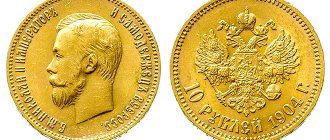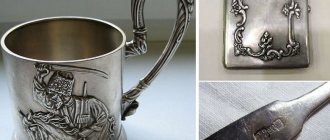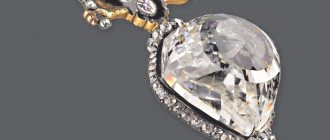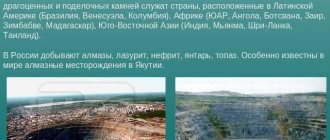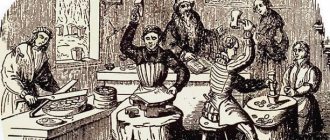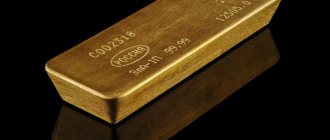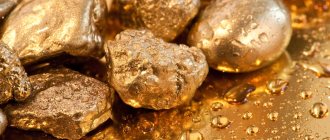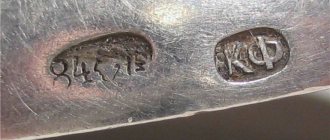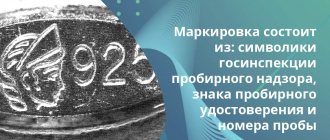Hello! Let's talk about history. At the very beginning of the 18th century, Peter I reformed the state system. The reason was an urgent need for money: the army, navy, the Northern War (it would last another 20 years) - all this required funds.
The reform took place in many stages and included various measures to influence the economy. We are interested in the fact that during the reform in 1701, the first royal gold coins, chervonets, were minted at the Kadashevsky Mint. The prototype of the royal chervonets was the European ducat, and this meant that the first circulating (circulation, settlement) coin appeared in the Russian Empire.
Before the chervonets, in Tsarist Russia, gold coins were donative - gift coins, intended for rewarding and expressing gratitude. They were presented to their subjects by the emperor and grand dukes as gratitude for their loyalty and on important occasions. Such money was not intended for everyday circulation and differed in mintage.
Now everything has become different - gold was included in the calculation, which was purchased in large quantities from China for this occasion. Since then, every Russian leader until the 20th century considered it necessary to imprint his profile on at least a small batch of money.
Types of gold coins from royal times
Royal coins began to be issued at the Kadashevsky Mint, and a little later the Red Mint joined in. This building in Moscow, not far from the Resurrection Gate, has survived to this day and has the status of an architectural monument of tsarist times. Under Anna Ioannovna, the Kadashevsky yard was closed, and the St. Petersburg Mint, founded in 1724, joined the Krasny one.
Peter I
In Peter's times, three types of gold coins were issued for regular minting and one for foreign payments.
Here are the three main coins of Peter I:
- chervonets;
- double chervonets;
- two rubles.
The gold chervonets of that time did not have a denomination. But there was a hint of the power of the Russian Empire over the seas: the Baltic, White, Azov and Caspian in the form of four cards minted on the reverse. On the royal chervonets, intended for internal payments, the inscriptions were in Cyrillic, on foreign ones - in Latin.
Two-ruble coins began to be minted in 1718 - they replaced the golden chervonets. This was probably done for the sake of economy: Chinese gold has risen in price significantly. For mutual settlements with Europe, ducats or their analogues were required, but gold royal coins with a face value of 2 rubles took root in the domestic market and were minted for two more generations of emperors.
Catherine I
Catherine I also carried out a monetary reform, but it affected only silver and copper. Catherine's gold coin was similar to Peter's - St. Andrew the First-Called was also minted on its reverse (as under Peter), but the portrait of Peter on the obverse was replaced by the profile of Catherine herself.
Peter II
Peter II continued the tradition and issued the same St. Andrew's 2 rubles (of course, with his portrait) in several versions. The production of the royal two-ruble coins was stopped only in 1729 - it became difficult to ignore their unsuitability for foreign economic calculations, because ducats were still needed in Europe.
Also in 1729, a new gold chervonets was issued, which had no face value, like the first ones, with a double-headed eagle and the coat of arms of Moscow on the reverse. The choice of coat of arms is strange at first glance - by that time, St. Petersburg had been the capital of the Russian Empire for 17 years. However, in 1728, Peter II planned to return Moscow to capital status and moved there himself - apparently, this intention is reflected in the gold coinage. It did not justify itself: in 1730 Peter died, and St. Petersburg remained the main city of the country for almost 200 years.
Anna Ioannovna
Empress Anna again reformed the royal financial policy. Peter's gold money was taken out of circulation, and new ones were minted in its place - of course, with the profile of Anna herself in an ermine robe. The chervonets did not have a denomination, but the standard increased sharply: 781 metric turned into 968. Coins became more expensive to produce, softer and required careful handling.
Under Anna Ioannovna, the Red Mint also minted a coin that has not survived to this day - the “Dutch chervonets”, the stamps for which have also not survived.
Elizabeth
Elizaveta Petrovna ruled for 20 years and during this time she managed to mint a lot of money. Of course, she herself was depicted on the obverse of all coins of her era. The reverses were different: there were a chervonets and a double chervonets with the image of St. Andrew the First-Called and the same coins with a double-headed eagle. The denomination on the royal money was again missing.
Brand new gold coins were also issued:
- Trial denominations of 5 and 10 rubles (imperial and semi-imperial), called “Elisavetin Gold”.
- Trial denominations of 1 and 2 rubles.
- Coins for palace use in denominations of 1, 2 rubles and 50 kopecks are the so-called “dvortsovki”. There is evidence that they were used more widely and were used for payments by ordinary citizens, although they were issued mainly for card games.
“Palace” coins continued to be produced after the death of Elizabeth - Russian emperors were not inclined to asceticism and royally enjoyed the luxury available to them.
Peter III
Peter III continued the minting of gold imperials and semi-imperials with a composition of coats of arms on the reverse (the royal coat of arms was located in the center) - and the same chervonets, an analogue of European ducats. The mass of a chervonets without a denomination was equal to the mass of a ducat - 3.47 g, diameter - 20 mm. The previous royal chervonets had approximately the same parameters.
During the reign of Peter III, chervonets began to be produced for the first time at the St. Petersburg Mint; before that, only Krasny was involved in them.
Catherine II
Catherine the Great began secretly issuing “Dutch ducats” - an imitation of European money. Evidence of him, modest at that time, dates back to the reign of Anna Ioannovna. Europeans treated such money more loyally than the royal gold chervonets. In addition, under Catherine, the proportional relative value of gold and silver was officially established (in 1764) - before this, exchange rate fluctuations interfered with calculations.
The production of tsarist imperials, half-imperials (10 and 5 rubles), two-ruble coins, rubles and half-rules - coins with a face value of 50 kopecks - continued.
There is information about a ruble coin allegedly for participants in the palace coup, minted in 1762 in the amount of 10 pieces. It is present in many catalogues, but we have no reliable information about it. If such a royal ruble were now found in a private collection, it would be worth a colossal amount of money.
Paul I
Under Paul I, there were only two regularly minted coins. This:
- A golden chervonets with a double-headed eagle (or Paul’s monogram) and the inscription “Not for us, not for us, but for Your name.”
- Royal semi-imperial made of almost pure 986 gold.
You probably noticed that Paul I - alone of all - suddenly changed the narcissistic tradition and minted coins without his own portrait. Why - one can only guess. It’s not a matter of appearance: portraits of Paul have been preserved, which he did not refuse, and there was nothing repulsive in his face.
There is a version that, unlike his predecessors, who were busy with palace intrigues and costly wars, Paul I considered getting out of the crisis and paying off debts as his priorities (Catherine left him millions in loans as an inheritance). The new emperor wanted to rely on internal resources and ordered the minting of coins that were the simplest, cheapest to design and produce.
According to some information, initially the gold chervonets with the profile of Paul I was in the project, but it had to be abandoned due to the need to urgently revise the denominations and technology for issuing coins.
Alexander I
In addition to the usual imperials and semi-imperials, under Alexander I, mints minted gold coins in denominations of 25 and 50 zlotys for introduction into use on the territory of the Kingdom of Poland, which was accepted into the Russian Empire by the decision of the Congress of Vienna in 1815. Zlotys were made from 917 standard metal.
The issue of “Dutch chervonets” continued. Some test royal coins were also produced, about which it is now difficult to say anything.
Nicholas I
Nikolai, nicknamed Palkin, added Russian-Polish money with double denominations to the Polish zlotys: 3 rubles - 20 zlotys. They were minted in St. Petersburg and Warsaw after military operations in Poland (Polish Uprising, 1830–1831).
Another new Nikolaev coin is a commemorative one, issued in honor of the beginning of minting gold from the Kolyvano-Voskresensky mines (with a face value of 5 rubles). Unnominal royal “ducats”, gold semi-imperials and imperials also remained in circulation.
Alexander II
Under Alexander, semi-imperials continued to be produced and a new regular gold coin appeared - 3 rubles. It was ordered to be issued instead of “Dutch ducats”, which was done, but the remains of them were still circulated among the people for 2 rubles 85 kopecks. They released a limited edition of commemorative royal 25 rubles of 1876, commissioned by Grand Duke Vladimir Alexandrovich in honor of his thirtieth birthday.
Zlotys were not minted under Alexander, but the production of Finnish stamps was established for the Principality of Finland, which became part of the Russian Empire as a result of the Russian-Swedish war (1808–1809). The Helsingfors Mint, established in 1861, was used to issue gold stamps.
Alexander III
The Tsar the Peacemaker continued the production established by his father, and until 1885 he issued the same gold coins.
In 1885, he published the “Rules on the Coin System” and stopped issuing three-ruble notes, but he resumed two traditions at once:
- minting of royal imperials;
- image on gold coins of one’s own portrait.
Nicholas II
Nicholas, who is now often called the Saint, and was called the Bloody by his contemporaries, from 1897 to 1899 minted a new gold denomination - 15 and 7.5 rubles. By this time, monetary circulation in Russia was already relatively orderly; S.Yu. was appointed Minister of Finance. Witte, and the ruble actually devalued by ⅓ - now the same amount of gold has become one and a half times more expensive.
Nicholas issued gold donation coins in honor of his coronation and fortieth anniversary and tried to establish the production of “Russ” - a monetary unit planned for the introduction, which was never destined to enter into circulation.
Guinea
England, 17th century
Two guineas of Charles II. 1664 Wikimedia Commons
In 1660, the only experiment with republican rule in English history ended: after two decades of civil wars and political chaos, the king returned to the country. This was Charles II Stuart, son of Charles I, who was executed in 1649. The new monarch was in a hurry to erase all memory of the time when the country was ruled by the murderers of his father. In particular, he was impatient to force the money minted by them out of circulation and replace it with new ones, with his image. The problem was that the Royal Mint was constantly experiencing a shortage of raw materials. England's own natural reserves of silver were small, and it was unprofitable to mine it, since the market was flooded with cheap silver from the Spanish colonies in America. England did not have its own gold deposits at all. That is, in order to mint coins, it was necessary either to buy metals abroad or to buy back old coins from one’s own population.
Soon after his accession, Charles established the Company of Royal Entrepreneurs trading with Africa. It quickly unfolded in Guinea, a region in western Africa from which Europeans exported slaves, ivory and gold. Charles began minting a new coin from Guinean gold, called the guinea.
The history of English money in the second half of the 17th and early 18th centuries is mainly the history of the struggle to preserve the bimetallic standard, that is, a monetary system based on a solid ratio of gold to silver. In Amsterdam, then the world center of foreign exchange transactions and trade in precious metals, one weight unit of gold was equivalent to 15 units of silver. In England, gold was valued higher - at least 15.5 units. This was mainly due to the fact that there were a huge number of old, roughly hand-minted silver coins in circulation (many of them were issued 40, 50, or even 100 years ago), worn out and cut off at the edges, as well as counterfeits. No one trusted silver money, while guineas, relatively rare and well protected from counterfeiting (they were minted by machine), enjoyed universal trust and therefore traded at a premium to the nominal price.
The guinea had a denomination of 1 pound sterling. The pound sterling was an English monetary unit, originally (around the 11th century) literally a pound (just over 450 grams) of small silver coins called sterling. Under Charles II, it actually contained only about 120 grams of silver (a pound was equal to 20 shillings, each coin contained approximately 6 grams). (20 silver shillings), but in fact it was never paid for less than 21 shillings. This meant that if you melted silver money into bullion, took it to Amsterdam and sold it there by weight, you could make a profit of five percent minus production and transport costs (silver was more expensive as a commodity than as English coins). By the 1690s, the guinea had reached 30 shillings. Profits from the export of silver from England increased so much that the silver money leaving the Royal Mint in the Tower often did not have time to cool before it was melted down to be sent to Amsterdam.
The next attempt to save English bimetallism was the Great Recoinage of 1696: the treasury bought old silver money from the population at the market rate, and in return issued new, full-weight, machine-made ones. After recoining, the guinea rate dropped from 30 to 22 shillings. The mint at this time was headed by Isaac Newton. In 1717, he proposed legislation to prohibit the exchange of a guinea for more than 21 shillings. But even after this, a unit of silver in the Netherlands or France was still worth more than in England, and its outflow never stopped. The English government abandoned further attempts to establish a fixed ratio of gold to silver and actually switched to the gold standard (however, this was legislated only a century later).
The minting of guineas ceased in 1813, and in 1817 the £1 sovereign was issued as the new standard gold coin. However, the guinea survived as a unit of account equal to 21 shillings (1.05 pounds) until the pound was converted to decimalization in 1971. It is precisely as a counting unit that it is found every now and then in Victorian literature, including in the stories about Sherlock Holmes.
The rarest and most expensive coins of the period of Tsarist Russia
You can buy a coin at auction for $400 and sell it for £1.5 million. This happened in 2008 to a man (his name is unknown) who accidentally acquired an Elizabethan gold coin of 20 rubles (double imperial) in 1950. It was released as a test batch and never appeared in circulation. Besides the copy sold in 2008, only one is now known - it is kept in the State Hermitage (St. Petersburg).
Proof and non-circulation coins are expensive due to their rarity. But regular royal coinage is also valued, especially:
- Royal coins with manufacturing defects or those that were minted after the first issue using new stamps. This made the first printing rare.
- Money, most of which was melted down, like “Dutch ducats,” which were hastily replaced with gold royal three-ruble notes.
Not all collectible coins are made of precious metals. History is valued more than gold, and the cost of a copper penny can be fabulous, if this penny is from tsarist times, and even more so rare.
Efimok with a sign
Russia, XVII century
Efimok with a sign. 1655 Coinage on a 1637 thaler Wikimedia Commons
The main problem of monetary circulation in Russia since ancient times was the lack of its own precious metals. There are no large deposits of either gold or silver on the East European Plain, and Siberian deposits began to be truly developed only in the mid-18th century. Before this, money was minted only from imported silver. In the 16th–17th centuries, as a rule, it was brought in the form of thalers - large European coins with which foreign merchants paid for Russian export goods. The oldest of these coins was the Joachimsthaler from the beginning of the 16th century. The last Joachimsthaler was minted in 1528. In Russia it was nicknamed efimko. The same name subsequently spread to other thaler coins. The most famous thaler coin is the piastre. Thaler coins were also minted by Lubeck and Hamburg (cities included in the Hanseatic Trade Union), England (silver crown). The Dutch Levendalder was formally also a thaler coin, but in fact it had a lower standard and was valued lower. Silver came to Russia mainly in the form of a variety of North German thaler coins and Löwendalder coins.
At Russian money courts, efimki were melted, and kopecks were minted from the resulting silver (the ruble existed only as a unit of account; in physical form it was represented by a pile of 100 kopecks). An average of 64 kopecks came out of one efimka. At the same time, the official exchange rate from the middle of the 17th century was 50 kopecks per efimok - the difference was the treasury’s profit.
In 1654, under Tsar Alexei Mikhailovich, a major monetary reform was carried out in Russia: copper pennies began to be minted, and a silver ruble was introduced on the model of the thaler. The problem was that the ruble in the old silver kopecks, which still formed the basis of circulation, contained about 47 grams of silver, while the new ruble contained only 28–29 grams. The commodity price of old money turned out to be significantly higher than the nominal value, and people began to hide them. The new ruble turned out to be unviable.
Already in 1655, the tsar's advisers invented a new technique: thalers were not melted, but were simply minted with a penny stamp (this was called a “sign”) and issued into circulation at a face value of 64 kopecks. At the same time, the treasury did not lose anything, saving on waste (loss in the weight of silver during smelting) and on the wages of money masters.
However, the efimok with the sign also did not last long: copper money soon almost completely replaced all silver from circulation, prices began to rise, and it ended with the Copper Riot of 1662 and the abolition of all innovations in the monetary sphere. The ruble, modeled on the thaler, appeared in Russia only half a century later on the initiative of Peter I.
Is it worth investing in gold coins?
It is possible to invest profitably in royal gold, but it is worth studying in advance the pros and cons of such an investment.
Expert opinion
Alexander Ivanovich
Private collector with 4500+ coins and bonds in his personal collection. Knows the value of each of them today.
The value of royal coins varies from several hundred or thousand rubles (the least rare small money) to millions. The semi-imperial of 1869 (the reign of Alexander II) will cost 30-35 thousand rubles, but the gold Nicholas imperial of 1896 (the last circulation before devaluation) will cost 8,000,000.
What about today?
The value of the gold coin today cannot be overestimated. Storing savings in this format ensures stability and security of investments. The advantages that contribute to the choice of gold for investment are:
- reliability of purchase and sale transactions;
- purchasing coins in any region of the country;
- correspondence of the cost of products to prices on the world market of precious metals;
- selection of denominations of various denominations.
Citizens of Russia can buy products whose weight ranges from hundredths of a gram to 5 kilograms (anniversary limited edition).
Regardless of the state of the economy and political situation in the country, gold is still the best way to store and increase funds. If you have already decided to invest in gold coins, then this is the place for you.
Advantages and disadvantages
Here are the positive qualities of investing in antique coins:
- Potentially High Returns – Antiques appreciate in value over time, and your coin could skyrocket in value if it is rare and well-preserved.
- The opportunity to find an expensive rarity for next to nothing (the probability is small, but it exists).
- An opportunity to collect a collection - a number of gold coins from the same era. It will cost more than if sold separately.
- The absence of a certificate does not devalue the gold (as is the case with a bullion).
Those who decide to invest in antiquities should also be aware of the negative aspects. I will include among them:
- The need for deep immersion in the topic. If you are not ready to get carried away with numismatics, but want to have “real” gold in your assets, it is better to focus on investment coins.
- VAT, which is levied on money out of circulation. This is where bullion coins also win.
- Problems associated with restrictions on the export of antiques abroad.
- Expenses for conducting an examination (from 500 rubles to several thousand per coin).
- The need to handle the collection with extreme care. This is not just gold, but also a unique stamp, already damaged by time, which cannot be restored.
To summarize: numismatics is a specific area that you need to understand if you want collecting to generate income. Investing in Tsarist gold will pay off if you are interested in history and involved in the collecting community.
Time for triumph
The most striking moment in the history of gold coins can be called the 19th century. This time is characterized by the depreciation of silver and the incredible demand for the royal chervonets of Russia. The reason for the excitement in Europe, in this case, are:
- metal quality (the coin is minted from 900-karat gold);
- the ratio of the precious metal in the product, where a 9 gram chervonets contains 7.8 grams of pure gold;
- stability of the ruble, in which the Russian currency is confirmed by the country's gold fund until the revolution.
After the change of power, the ruble was withdrawn from circulation, but the significance of the mint remained unchanged. The gold coin has changed its appearance, but has not ceased to be relevant. Banknotes were used as a means of circulation until the mid-20th century. In the period after World War II, gold coins changed their purpose, becoming an investment vehicle.
Where can you buy or sell
A rare gold coin is not a product that can be sold in one day. First of all, such gold is sold in antique stores and at numismatic auctions. Trading platforms are based on the Internet, for example:
- Anumis;
- Volmar;
- Raritetus;
- Monetshop;
- Imperial;
- Conros;
- Numismatist and others.
You should not look for buyers of ancient coins on bulletin boards: even if someone covets your product, most likely it will be a scammer who buys expensive things for next to nothing from people who do not know their real value.
If you are a novice collector, pay attention to thrift stores and flea markets (for example, Udelny in St. Petersburg). Sometimes you can find unique antiques on them, including royal coins.
Prices for royal gold coins today
The table shows how much gold royal coins are worth now (depending on the type, according to the portal monetnik.ru).
Pesos
Spain, XV century
Pesos. After 1497 Wikimedia Commons
When Europeans, represented by Vasco da Gama, discovered a direct sea route to India in 1498, they expected profitable trade, but found that they had nothing to offer eastern merchants. Europe was then a backwater of the world economy and did not produce anything that would interest Indians.
Around the same time, Spanish conquistadors conquered Mexico and Peru. By the middle of the 16th century, in what is now Bolivia, they discovered several huge deposits of silver, including the famous Potosi, or Cerro Rico (“Rich Mountain”), consisting almost entirely of silver ore. Silver was in constant demand in the East, and it was this that flowed there from the West in exchange for silk and spices.
At mints built right next to the mines, the Spaniards minted pesos (Spanish pesos de ocho, literally “peso-eight”: 1 peso was exchanged for 8 reais) - large silver coins modeled on the German thaler (weight - 28-29 grams, purity - about 80%). From the New World, pesos spread around the world in two huge streams: the first - across the Atlantic Ocean to Seville and from there throughout Europe and the Mediterranean, as well as to India along the route laid by Vasco da Gama; the second - across the Pacific Ocean to China and the islands of the Malay Archipelago. On the second route, the main transshipment point was Manila in the Philippines, founded by the Spaniards in 1571 - from that moment on, flows of silver surrounded the entire globe and trade became truly global.
By the end of the 16th century, Spanish pesos-octets, minted in Mexico and Peru, had become the most common silver coin in the world. They were used to pay everywhere - from Jamaica to Java and from Arkhangelsk to the Cape of Good Hope. It was the first truly global currency. It remained in this status until the end of the 18th century.
The coin had many names in different languages. For example, in English it was called either a piece of eight (the literal translation of the phrase peso de ocho, that is, “a piece of eight [reals]”), or a dollar (a distorted “thaler”); in Chinese - shuangzhu (“two pillars”, after the image of the Pillars of Hercules on the Spanish coat of arms, which was minted on a coin); in Italian - piastra (translated as “tile”, “ingot [of silver]”). From this last name comes the most popular Russian name for the peso-octagon - piastre.
Is it profitable to sell 10 rubles? (1898-1911)?
Sale 10 rub.
Price of gold ten rubles
| Year Coins | Purchase price From | Purchase price Before |
| 1898 | 30 000 | 39 000 |
| 1899 | 30 000 | 39 000 |
| 1900 | 31 000 | 40 000 |
| 1901 | 31 000 | 40 000 |
| 1902 | 31 000 | 40 000 |
| 1903 | 31 000 | 40 000 |
| 1904 | 35 000 | 55 000 |
| 1906 | rarity | |
| 1909 | 37 000 | 65 000 |
| 1910 | 75 000 | 155 000 |
| 1911 | 31 000 | 39 000 |
Price list date 2021-10-15 The purchase price is indicated in rubles.
The table shows approximately what the cost of ten rubles is. It will be possible to say more specifically after an assessment by our specialist (for this we invite you to a store in Moscow). The cost is due to the fairly large number of products. For example, the circulation in 1900 was 5,372,000. In total, more than 60,000,000 pieces were issued during minting. But 10 rubles. 1910 is considered expensive. If you are interested in how much the 1898 coin costs, come to our store in Moscow.
Coin characteristics:
- diameter – 22.5 mm,
- weight – 8.6 grams (7.74 of which are pure gold).
Compared to the “imperial”, the ten-ruble coins have “lost weight”. This is due to the difficult economic and political situation.
You get up to 80% of the real market price
+7(800)333-14-77
The office is under guard. Petrovka 38 nearby
Cost 10 marks for Finland
Fig 1. Photo of 10 stamps
How much can you sell 10 stamps for in Moscow?
| Year Coins | Purchase price From | Purchase price Before |
| 1904 | 45 000 | 120 000 |
| 1905 | 115 000 | 225 000 |
| 1913 | 18 500 | 28 000 |
Price list date 2021-10-15 The purchase price is indicated in rubles.
10 stamps for Finland are of interest to numismatists. If you want to sell gold 10 marks, please contact the store in Moscow. Under Nicholas II, coins were minted only in 1904 and 1905. The copies are considered rare: in 1904, only a little more than 100 thousand appeared, and in 1905 - almost 43 thousand pieces. We also buy such items in our store. The 10 stamps for Finland have the following features:
- 900 gold standard,
- 3.23 grams of weight,
- 19.1 mm in diameter.
Sell 20 stamps for Finland
20 Finnish marks
At what price can you sell 20 stamps?
| Year Coins | Purchase price From | Purchase price Before |
| 1903 | 25 000 | 35 000 |
| 1904 | 25 000 | 35 000 |
| 1910 | ||
| 1911 | 25 000 | 35 000 |
| 1912 | rarity | |
| 1913 | 25 000 | 35 000 |
Price list date 2021-10-15 Purchase price is indicated in rubles.
20 stamps were minted in 1903 and 1904. Circulations are 112,000 and slightly more than 188,000, respectively. Expensive items from 1904 and 1905. Place of minting: Helsingfors Mint. 20 stamps are made of the same material, but their weight is almost 2 times greater (6.45 grams), and their diameter is 21.3 mm.
What investment coins can you buy today?
The most famous of the modern investment coins is St. George the Victorious.
You can also purchase:
- Sower.
- Russian ballet.
- Zodiac signs.
- River beaver.
- Winter Olympic Games.
- History of monetary circulation in Russia.
- FIFA World Cup 2022.
Why are chervonets and 15 rubles with Nicholas III a priority in Russia?
Coins of 5 and 10 rubles, which became 7.5 and 15 rubles respectively as a result of Witte’s monetary reform, formed the basis of the monetary circulation of the Russian Empire. They were produced in millions of copies and were widely distributed.
Interesting fact: the 10-ruble imperials, which were minted in 95-97 of the 19th century, represent a statistical anomaly. Although this example is not very rare (its circulation was 125 pieces annually, about 375 in total), collectors are willing to shell out up to a quarter of a million dollars for it.
How much do investment gold coins cost in Sberbank of Russia today?
Expert opinion
Lyudmila Pestereva
Our most experienced gold investor
Ask a Question
The cost of investment coins in Sberbank ranges from 25 to 40 thousand per copy, made of gold, worth 50 rubles and weighing 7.78 grams of pure gold. Why there is such a difference in price is difficult to answer. Sberbank of Russia does not comment on pricing on its website: it probably depends on the expected demand for individual copies.
The bank also offers wholesale pricing options for batches of 10 items and above. The price is reduced by 1-2 thousand per unit.
The most expensive copy - Suvorov 2000, which, however, does not belong to investment coins, but to commemorative signs, with a similar weight and denomination - is offered to be purchased for 400 thousand.
Sell 7 rub. 50 kopecks (1897)
7 1/2 rub.
How much can you sell 7.5 gold rubles for?
| Year Coins | Purchase price From | Purchase price Before |
| 1897 | 33 000 | 49 000 |
Price tag date 2021-10-15 Purchase price is indicated in rubles
The appearance of a product with an unusual denomination was associated with monetary and economic reforms. For 1 year - 1897 - minting was carried out under the leadership of Apollo Grashof. The circulation was just over 5,000,000 pieces. Experts who professionally evaluate coins indicate that these items resemble the five-ruble coins of Alexander 2.
Characteristics:
- denomination – 7 rubles. 50 kopecks,
- weight – 6.45 grams (5.81 – pure gold),
- circulation - just over 5,000,000,
- diameter - 21.3 mm.
The items are considered rare because they were not minted during Soviet times. Be careful: Nikolaev coins from rare minting years were often counterfeited. find out how much Nicholas 2 gold is worth after a professional appraisal. Our specialists will conduct an assessment and then offer terms of purchase.
Moscow center, 2 minutes from the metro
+7(800)333-14-77
Instant cash or non-cash payment

